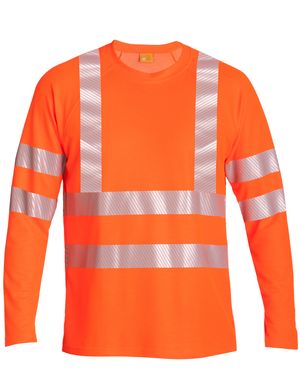KANBrief 2/19

Sunshine is something very pleasant and is also very important for the human body. It can however also be dangerous, sunburn being the most obvious sign. Even without visible reddening of the skin, however, we add to our personal UV accounts each time we sunbathe, and our skin does not lose sight of the balance. Excessive exposure causes skin cancer, currently the most common form of cancer. Protection against solar radiation is therefore very important, especially at work.
In Germany, squamous-cell carcinomas have been formally recognized as an occupational disease since 2015, and employers are obliged to protect their employees against UV radiation and to provide suitable protective work clothing. An improvement in the situation is not in sight, however, since exposure to UV radiation continues to increase, year on year. On and in the water and against light backgrounds, reflection causes the UV radiation to rise considerably, and even in the shade, persons are still exposed to 50% of the original UV radiation level.
Owing to this high level of exposure, it is often not sufficient simply to apply cream to exposed areas of skin. Sun creams, even where they offer a high sun protection factor, are only a short-term solution, besides being inconvenient. They are effective only when applied in a thick layer, equating to around 20 to 30 millilitres for an adult. Sun creams containing chemical UV filters have the additional disadvantage of increasing perspiration, since they convert the UV radiation into heat. Creams containing a mineral UV filter are difficult to apply, and give rise to a sticky feeling on the skin. Both types often attract dust, and fresh cream must be applied frequently. If normal T-shirts, for example made of cotton, are worn instead, they provide a UV protection factor of only ten, and when wet of only three. They are not therefore an adequate alternative.
One possible solution is the use of UV-protective shirts and caps, and neck shades on safety helmets. These forms of protection act entirely physically, without any form of chemical impregnation. The protective action is generally achieved by the use of very fine filaments in combination with a special weaving process. The result is a very dense, multi-layered fabric that blocks over 98% of the UV-A and UV-B radiation. Since the UV radiation does not reach the skin, these products are comfortable and light to wear.
The manufacture of personal protective equipment (PPE) is governed by the European PPE Regulation (EU) 2016/425, which replaced the PPE Directive in April 2018. The regulation contains a new requirement concerning PPE designed to protect the skin, including against UV radiation. This means that manufacturers and suppliers of protective work clothing providing UV protection must demonstrate that the PPE is “capable of absorbing or reflecting the majority of the energy radiated in the harmful wavelengths”. Consequently, where items of clothing feature specific UV protection, they now constitute PPE and must satisfy the relevant requirements of the regulation. For example, if UV protective shirts are used in road construction, they must also be designed and tested as high-visibility warning clothing to EN ISO 20471+A1:2016-11, "High visibility clothing – Test methods and requirements". Companies must ensure that only protective clothing with the relevant certification is used. Use of personal sun and heat protection of this kind is promoted by the OSH bonus awarded by the German Social Accident Insurance Institution for the building trade (BG BAU, in german).
Under the European PPE Regulation, protective clothing is governed by the harmonized European EN ISO 13688:2013-07, "Protective clothing – General requirements standard"; it formulates no requirements for UV protection, however. In the area of textiles, UV protection is classified and assigned a mark by EN 13758-2+A1:2006-12, "Textiles – Solar UV protective properties –Part 2: Classification and marking of apparel" or AS/NZS 4399:2017, "Sun protective clothing – Evaluation and classification". The requirements of the PPE Regulation are however not addressed systematically in these two standards.
No dedicated standard therefore exists for support of the essential requirements of the PPE Regulation with regard to protection of the skin against UV radiation. Besides a measurement method, such a standard should contain concrete requirements concerning the level of UV protection provided by the clothing, which should not excessively impair wearer comfort. If appropriate, consideration could be given here to existing standards such as the Australian AS/NZS 4399:2017 or the UV STANDARD 801, "General and special conditions for the award of the entitlement to mark consumer products with the UV STANDARD 801 label, 2019, International Testing Association for Applied UV Protection" developed in Europe by a number of test institutes. It is the task of the PPE standards committees to correct this deficit and thereby to support the manufacturers, the test bodies, and also the users.
Markus Courtial Dr Michael Thierbach
arbeitsschutz@iq-uv.com thierbach@kan.de